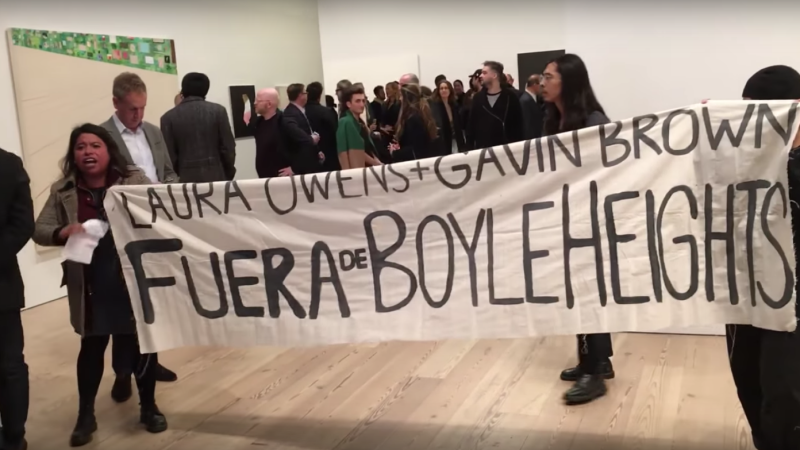In the Fight for Boyle Heights, Is Artist Laura Owens the Real Enemy?

From Jezebel is an article by Whitney Kimball that focuses on the class tensions between the artists and residents of Boyle Heights, as it uses Laura Owens and the gallery she helps run, 356 Mission, as a lens.
The article begins: “Laura Owens is not exactly a real-estate shark. New Yorker art critic Peter Schjeldahl characterizes the artist as a soft-spoken, earnest feminist who makes playfully wistful paintings and works with children and campaigns for Democratic politicians. So when a group of activists burst into the VIP reception for her “mid-career survey” at the Whitney Museum last week shouting “fuck Laura Owens!”—accusing her “racist entrepreneurial” art space of removing them from their homes—it looked like class rage had gone off the rails.”
This is followed by the statement that Laura Owens recently released on 356 Misson’s blog defending her commitment to the community and a summary of its details: “She wrote that she ‘cares deeply’ about the community and over the past 25 years has taught at local universities and served on the boards of nonprofit organizations. 356 Mission’s homepage explicitly states that it is not ‘entrepreneurial’; the gallery profits go entirely back to the events programming such as free youth workshops, performances by local artists, and political organizing meetings (some recent events: make Doll Clothes; Build Your Own Monster; Design your own T-Shirt; all materials provided and refreshments served). They have always operated, she said, at a loss.”
The article goes far to paint a critical and sympathetic portrait of both parties, underscoring the great division in values between Boyle Heights’s population, which is largely poor and working class, and artists, Laura Owens, and what Owens seems to represent. Kimball interviewed Nancy Meza of Defend Boyle Heights, and Meza pointed toward how the distinction between ‘artists’ and ‘residents’ reinforces the notion a whitewashed ideal of art: “Everyone here is an artist. Every day you’re surviving poverty you’re being creative, you’re using resources to survive.”
In the case of Boyle Heights, Laura Owens, 356 Mission’s their community projects are not altruistic ‘engagement’ but a projection of ideals of what art should be and were it should come from. The article continues: “‘This term ‘artist’ has this elitism to it,’ Caribbean-born and Flatbush-based performer Imani Henry, of the BAN Gentrification network… ‘There’s an idea that if it’s imported to a gallery or museum, that if it’s a white artist from Kansas, they’re an artist. Our art is criminalized.'”
“The most obvious difference is between the definitions of “street art” (neighborhood embellishment) versus graffiti (defacement of property). In New York City, white “singer/songwriters” are allowed to play acoustic covers on the subway platforms, but black and brown “Showtime” performers are arrested for doing acrobatic pole tricks on the train. ‘This is a perfect example,’ Henry said. ‘In 2015, a white woman from outside came into Bushwick and… made an installation on somebody’s house, which she didn’t live in. This is such a colonialist thing—I see a house over there, I discovered it.'”
The article concludes by again pointing at how ideals have shaped the aggressive clash between protesters and Owen, as it quotes Paddy Johnson: “Maybe you stop caring about how you draw your conclusions and what you call facts when you’re fighting for your home, your livelihood, and the livelihood of your family.”
For the full article, click the link below.